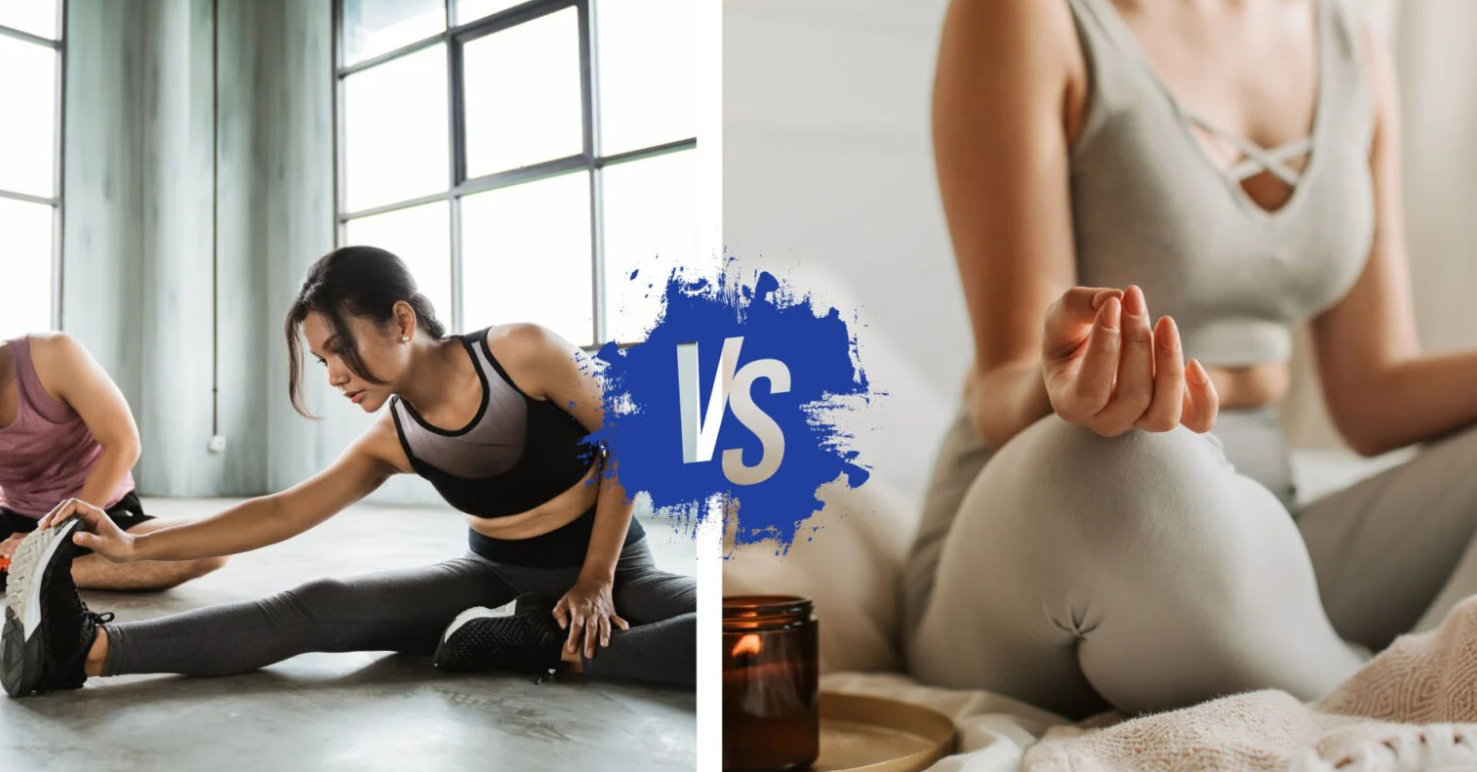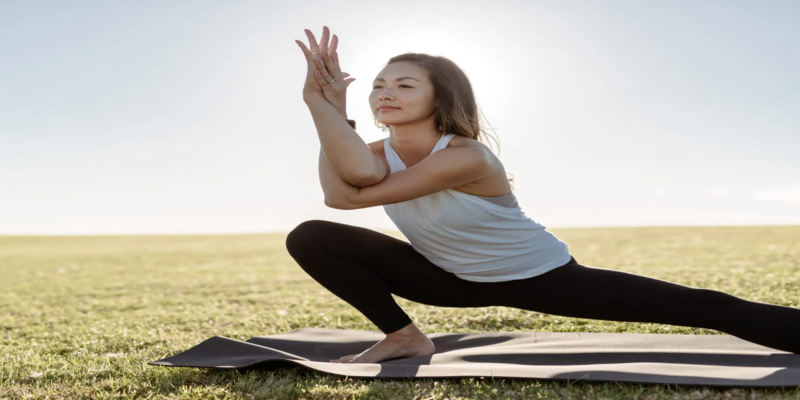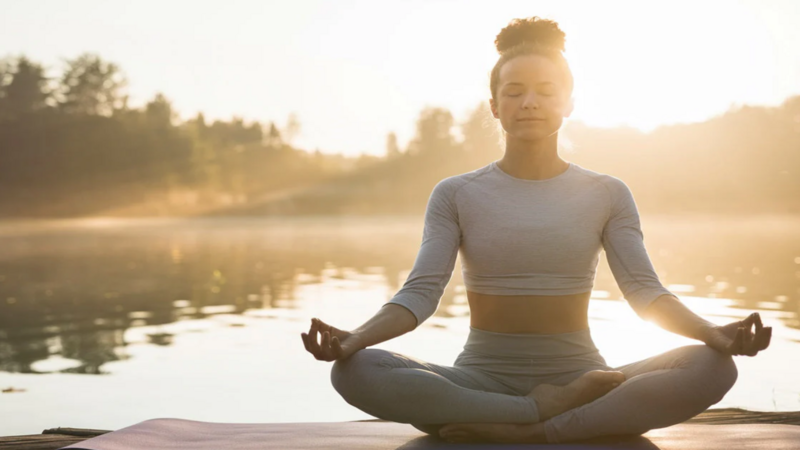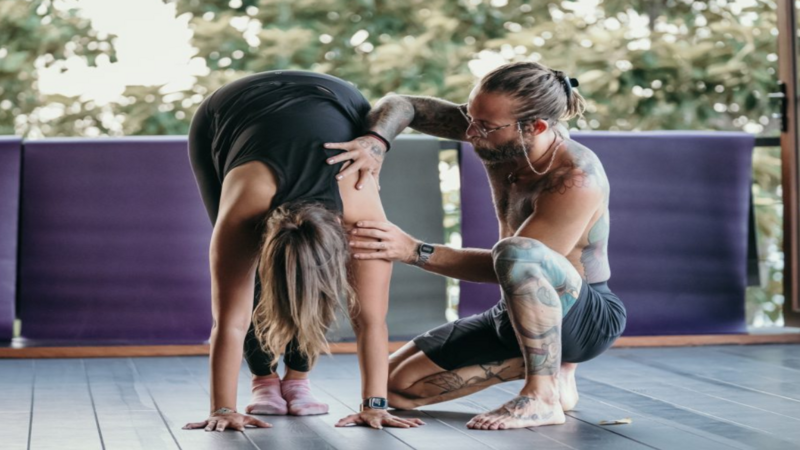Stretching vs Yoga: Which Is Better for Flexibility? Flexibility is crucial to ensure you have the right range of motion, and it also helps prevent injury. Now, the main question that comes here is what to do for flexibility training. Should we opt for stretching or yoga? For many people, yoga and stretching may seem like the same thing. But there are major differences between them.

In this article, we have discussed the differences between stretching and yoga. You will also be able to learn whether yoga is better than stretching and the best way to improve flexibility. Let’s jump right into the article and take a look.
What Is Stretching?
Stretching is a form that helps improve the flexibility of your body. In this physical activity, you can target a specific muscle or tendon of the body. The muscle is deliberately flexed and extended, which then helps with elasticity, flexibility, and muscle movement. Stretching for flexibility can be great; however, it will focus on specific parts of the body at one time. The key benefit of stretching is that it helps prevent injuries during workouts and is often performed as a warm-up or cooldown exercise after the workout.

There are two different types of stretches. Dynamic and static. Below, we have outlined what these two stretching methods are and how they can benefit you.
Static Stretching
Static stretching is a type of stretching in which the person holds the position for 15-60 seconds. This method is generally used when warming up for exercise or for cooling down after working out. It also helps improve the body’s flexibility and tone the muscles. It is great if you want to relax your muscles and also reduces the post-exercise muscle soreness.
Dynamic Stretching
Dynamic stretches are a much more controlled version. Here, the body muscles are thoughtfully engaged to improve muscle and joint movement, thereby increasing the range of motion. This type of stretch is great when it comes to increasing blood flow in the body and raising muscle temperature. It is also beneficial for improving body coordination and enhancing physical performance.
What Is Yoga?
Yoga is one of the most ancient practices that can help with flexibility. Yoga for flexibility has been practiced for over 5,000 years, and many different postures can help improve flexibility. Physical postures, such as asanas, breathing techniques called pranayama, and other exercises can help improve flexibility, strength, balance, and endurance. Not only can this yoga help reduce anxiety and stress, but it can also promote relaxation.

There are several yoga poses that improve flexibility, such as:
- Hatha Yoga: A gentle introduction that allows you to maintain your breathing.
- Vinyasa Yoga: A dynamic yoga pose where the movements are linked with breath techniques.
- Kundalini Yoga: This combines movement, chanting and meditation.
- Restorative Yoga: Focuses on relaxation and stress relief.
Other than this, there are a lot of other different kinds of yoga postures that are designed to improve time flexibility.
Flexibility Benefits of Stretching
Stretching offers a range of different benefits. Below, we have mentioned some of the main advantages of stretching for flexibility.
Increases Flexibility
The primary and most significant benefit of stretching is increased flexibility. An increase in flexibility can help you perform everyday activities with much more ease and also delay mobility issues that come with ageing.
Improves Range of Motion
Another major benefit you can gain from stretching is that it enhances your range of motion. It reduces the chances of injuries and gives you much more freedom when it comes to movement.
Increases Blood Flow
The blood flow to the muscles is also improved when you are doing stretching. Improving circulation in the muscles can help reduce recovery time and also alleviate muscle soreness after a workout.
Improves Postures
A major benefit of stretching is that it can help improve your posture. Stretching a specific group of muscles can help reduce musculoskeletal pain and promote proper muscle alignment, ultimately improving posture.
Flexibility Benefits of Yoga
Yoga for flexibility offers numerous major benefits, some of which are mentioned below.

Improves Flexibility and Balance
One of the key benefits of yoga is that it enhances flexibility and helps with body balance. Yoga helps stretch muscles, allowing your body to gain strength, and eventually, it will also improve your balance.
Stress Relief
Practical yoga practice also helps alleviate stress. Meditation and breathing techniques help relieve tension in the muscles and alleviate overall stress in both your mind and body.
Helps with Strength Building
Practicing yoga is also associated with building strength. You can target both the upper and lower body during yoga techniques, ensuring that your muscles become stronger and more powerful.
Stretching vs Yoga: Pros and Cons Comparison Table
Should I do yoga or stretching for flexibility? If you are also wondering about this, then don’t worry. Below, we have outlined the key differences between stretching vs yoga to help you choose the right one for yourself.
Aspect | Stretching | Yoga |
Purpose | Helps with muscle flexibility and range of motion | Great for improving balance and flexibility |
Mind Body Connection | Not much focus on mental health | Mental health and physical health both are deeply connected |
Posture | Targets specific muscle groups to improve posture | Promotes full body alignments and ensures healthy posture |
Physical Benefits | Help with muscle strength and mobility of the body | Builds strength, flexibility and balance of the body |
Variety | Static and dynamic stretches often the exercises are repetitive | There are a wide variety of poses and styles to target different needs |
Best for | Athletes, injury recovery or gym enthusiasts | Great for people looking for a holistic approach to fitness |
Time | Can usually be done in 5 to 10 minutes | Can take up to 20 to 60 minutes per session |
Accessibility | Beginner-friendly and easy to learn | Beginner-friendly but you might need some guidance in the starting |
Which One Is Better for You?
When it comes to becoming more flexible, the main question is is yoga better than stretching. These major lifestyle changes can impact your fitness goals, age, and overall well-being. If you want to increase flexibility naturally, then yoga vs static stretching can be good options. Static stretching can target specific muscles, making it a great addition to your daily stretching routine vs yoga, especially if you work out regularly. These are simple and quick, ideal for people who want to recover from an injury and something that can be done in a short period.
Yoga for flexibility can also be beneficial, but its advantages extend beyond flexibility. Yoga can help with movement, breathwork, and balance while improving overall body awareness. Many yoga poses help improve flexibility. Others can strengthen your core while some enhance your posture. Therefore, selecting the right yoga style for take-off is crucial if you want to learn how to become more flexible.
Understanding the differences between yoga and stretching can majorly help in choosing which is the right fit for you. The comparison between stretching vs yoga comes down to several factors, such as stretching being commonly used for warm-ups or cooldowns, whereas yoga is a holistic approach to fitness. Ultimately, yoga vs. static stretching can help with flexibility and better mobility, but in different ways.
Can You Do Both?
If you want to become more flexible, yoga and stretching can be an excellent choice. Both of these can be effective and are the right choice depending on your whole body type and daily routine. If you’re considering how stretching compares to yoga, it largely depends on the kind of flexibility you’re seeking. Stretching can be great if you want to target specific muscles; however, yoga is also beneficial for overall body flexibility and helps with mental focus.
If you are wondering if yoga is better than stretching, then the answer also depends on your needs. Yoga and stretching are both excellent for improving flexibility; however, yoga offers additional benefits, including mental focus, improved posture, increased strength, reduced stress, and enhanced overall well-being. Stress, on the other hand, works well for targeting tight muscles post-workout and improves physical activity and performance.
Hence, to increase flexibility naturally, you can combine both of these exercises. You can spend 5 to 10 minutes in the morning or before your workout for a daily stretching routine. You can practice yoga two to three times per week to improve your mobility. Hence, yoga vs static stretching can both be great for your body, improving flexibility.
Conclusion
If you are wondering what the best way to improve flexibility is, there is no definitive answer. People always wonder why I’m finding it hard to choose between stretching vs yoga; however, both of them have their benefits. Both of these can help improve flexibility if you consistently practice them and listen to your body. You can alternate between static stretching and yoga flows to discover what feels best for you and suits your body type. Therefore, a daily stretching routine versus a yoga routine can really help maintain your body shape, improve posture, increase mental focus, and reduce stress.



